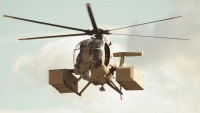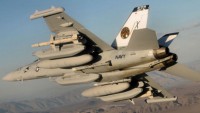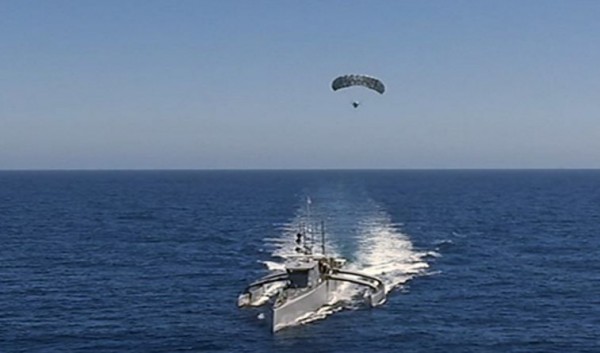DARPA Robot Submarine Killer Warship called ACTUV gets a ‘Spy in the Sky’
| Arthur Dominic Villasanta | | Oct 24, 2016 10:07 PM EDT |
(Photo : DARPA) TALONS flies over an ACTUV.
DARPA's "Anti-Submarine Warfare Continuous Trail Unmanned Vessel" (ACTUV), an autonomous robot submarine hunter built to patiently chase and destroy stealthy Chinese submarines over the vast Pacific Ocean, will soon get an "spy-in-the sky" that will make it even deadlier.
ACTUV seeks to lay the technical foundation for an entirely new class of ocean-going warships: robots with AI (artificial intelligence) brains able to traverse thousands of kilometers over the open seas for a month at a time without a single crew member aboard.
Like Us on Facebook
ACTUV is now testing its first payload, the prototype of a new elevated sensor mast developed through DARPA's "Towed Airborne Lift of Naval Systems" (TALONS) research effort.
Towed behind boats or ships, TALONS can persistently carry intelligence, surveillance, reconnaissance (ISR) and communications payloads of up to 150 pounds between 500 and 1,500 feet in altitude (many times higher than current ships' masts) and greatly extend the equipment's range and effectiveness against submarines and surface warships.
The TALONS prototype tested its onboard sensors and communications equipment during a recent evaluation trial. Once the test was complete, the prototype reeled itself in back to its ACTUV berth called a nest. The entire process took place as the ACTUV vehicle maneuvered at operationally realistic speeds.
While aloft, TALONS demonstrated significant improvements to the range of the sensors and radios it carried compared to mounting them directly on a surface vessel.
TALONS' surface-track radar extended its range by 500 percent -- six times -- compared to its range at sea level. Its electro-optical/infrared scanner doubled its observed discrimination range.
"I was delighted to explore the possibility of hosting TALONS on ACTUV and from my perspective, the testing could not have gone better," said Scott Littlefield, DARPA program manager for ACTUV.
"We just started at-sea testing of ACTUV in June, and until now we've been focused on getting the basic ship systems to work. TALONS was our first chance to demonstrate hosting a real payload and showing the versatility of ACTUV to do a wide variety of missions for which it wasn't originally designed."
"TALONS showed the advantages of using a low-cost add-on elevated sensor to extend the vision and connectivity of a surface asset and ACTUV demonstrated its ability as a flexible and robust payload truck," said Dan Patt, DARPA program manager for TALONS.
"This demonstration was an important milestone in showing how clever use of unmanned systems could cost-effectively provide improved capabilities."
TALONS is part of DARPA's Phase 1 research for Tern, a joint program between DARPA and the U.S. Navy's Office of Naval Research (ONR). Now that at-sea demonstration is complete, DARPA is transitioning TALONS to the Navy.
TagsAnti-Submarine Warfare Continuous Trail Unmanned Vessel, ACTUV, DARPA, Towed Airborne Lift of Naval Systems, TALONS, U.S. Navy
©2015 Chinatopix All rights reserved. Do not reproduce without permission
 Hackers Almost Cripple the Internet by Weaponizing IoT Devices as Botnets
Hackers Almost Cripple the Internet by Weaponizing IoT Devices as Botnets DARPA Developing Windowless APC so Soldiers Inside can See Better
DARPA Developing Windowless APC so Soldiers Inside can See Better DARPA has Just Developed Hack Proof Code and Proved it Works
DARPA has Just Developed Hack Proof Code and Proved it Works DARPA Launches Contest to Make AI-powered Military Radios that are Really Smart
DARPA Launches Contest to Make AI-powered Military Radios that are Really Smart DARPA Developing Next Gen US Electronic Warfare Systems Masterminded by AI
DARPA Developing Next Gen US Electronic Warfare Systems Masterminded by AI
EDITOR'S PICKS
-

Did the Trump administration just announce plans for a trade war with ‘hostile’ China and Russia?
-

US Senate passes Taiwan travel bill slammed by China
-

As Yan Sihong’s family grieves, here are other Chinese students who went missing abroad. Some have never been found
-

Beijing blasts Western critics who ‘smear China’ with the term sharp power
-

China Envoy Seeks to Defuse Tensions With U.S. as a Trade War Brews
-

Singapore's Deputy PM Provides Bitcoin Vote of Confidence Amid China's Blanket Bans
-

China warns investors over risks in overseas virtual currency trading
-

Chinese government most trustworthy: survey
-

Kashima Antlers On Course For Back-To-Back Titles
MOST POPULAR
LATEST NEWS
Zhou Yongkang: China's Former Security Chief Sentenced to Life in Prison

China's former Chief of the Ministry of Public Security, Zhou Yongkang, has been given a life sentence after he was found guilty of abusing his office, bribery and deliberately ... Full Article
TRENDING STORY

China Pork Prices Expected to Stabilize As The Supplies Recover

Elephone P9000 Smartphone is now on Sale on Amazon India

There's a Big Chance Cliffhangers Won't Still Be Resolved When Grey's Anatomy Season 13 Returns

Supreme Court Ruled on Samsung vs Apple Dispute for Patent Infringement

Microsoft Surface Pro 5 Rumors and Release Date: What is the Latest?










